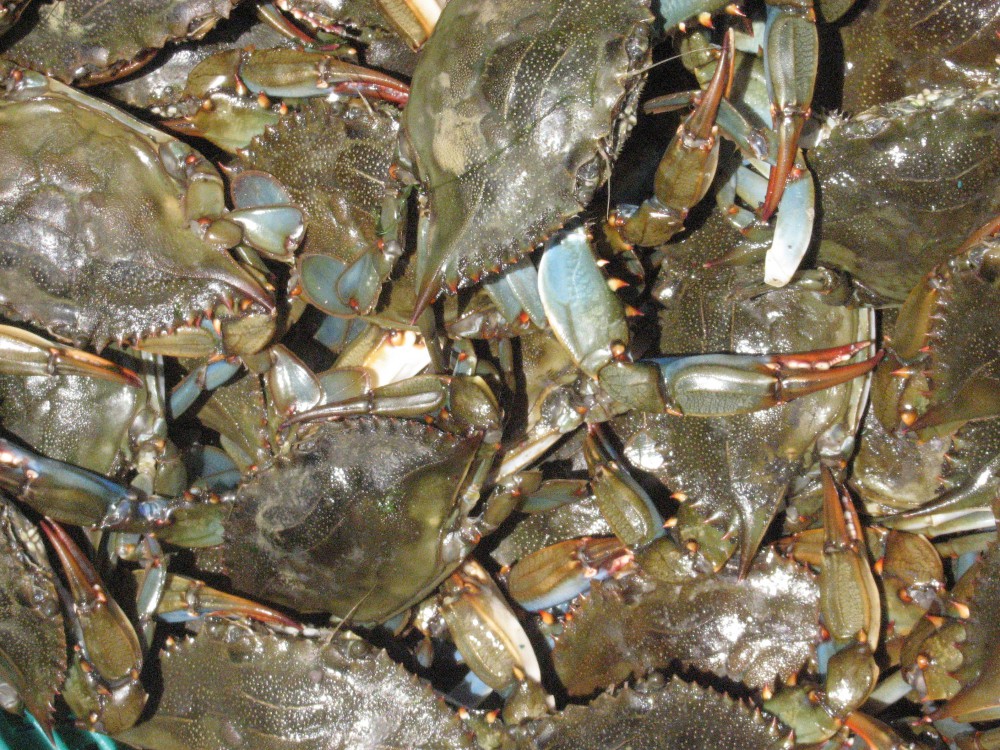
by Rick O'Connor | Oct 23, 2015
Well… we have talked about the “big two”… snapper and shrimp, but there are other popular fin and shellfish harvested from the Gulf of Mexico. This week we look at my personal favorite… blue crab.
Probably like many of you out there, the very first sea creature I ever caught was a blue crab. It was with one of those classic basket traps where you baited it, lowered to the bottom where you could see, waited until a crab came for the bait, and pulled her in… GREAT fun. My parents cooked the crab, saved the shell and dated it. It sat on the cabinet above our breakfast bar for years. It was something I did every summer off the dock of the house we rented on Pensacola Beach… good times.
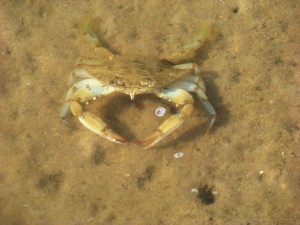
The thin telson beneath this crab indicates it is a male.
Photo: FWC
As I got older we switched from crab traps to hand-held crab nets. We would spend hours searching the grass beds around Gulf Breeze collecting and cleaning these guys. I remember cleaning over 60 of them once until my hands bled, that was about the time I thought I would let the commercial guys do this and I would just buy it from them!
As much fun as I had catching them, I had just as much fun cooking. My wife and I would make deviled crab and one of my personal favorites of hers, crab meat baked on an English muffin with cheese. Man o’ man. What a great creature the crab.
There are about 4500 species of “true crabs” found on our planet and many are valuable as a seafood product. In the Florida Panhandle it is the Blue Crab most seek out. In recent years commercial and recreational crabbers have noticed a decline in their numbers. Landings of blue crab ranged between 8 and 12 million pounds in Florida from 1982-1999 and since 2000 the landings have ranged from 4 to 8 million pounds. Researchers with the Florida Fish and Wildlife Conservation Commission have run several models to determine why the decline in landings has occurred. Though the decline in the Chesapeake may be due to overfishing, the models do not suggest this for Florida. They are not sure why the decline has happened but do have data that support the argument that freshwater discharge during heavy rain events does impact their population in a negative way. Some data suggest the increase in salinity during drought conditions has done the same. Whatever the reason, many would like to see their numbers rebound to the 12 million lb. landings we had just a few years ago.
Blue crabs typically live to be 1-2 years old, though some have been aged to 5 years. Males prefer the less saline waters of the upper estuary and the females can be found throughout the bay. Males reproduce more than once in their lives providing the females with a sack of sperm called a spermatophore. Females mate only once, just after their last molt. Once she has received the spermatophore she heads for the mouth of the bay where the water is more saline, she may enter the Gulf of Mexico searching for the right habitat. When she fertilizers her eggs they remain with her as a mass on her underside; the egg mass resembles a sponge. The larva hatch from this mass and go through several development stages as they re-enter the estuary and begin the cycle again.

Whatever the reason for their decline, and recent increase in price, these crustaceans remain a Gulf coast favorite and I for one hope they remain around for a long time.

by Rick O'Connor | Oct 17, 2015
If shrimp are king of the shellfish industry, then red snapper are the king of the finfish world. It is arguably the most economically and ecologically important reef fish in the Gulf of Mexico. This fishery began in 1872 with four “snapper smacks” out of Pensacola. By 1890 the fleet had grown to 34 vessels and had extended to other panhandle ports as well as Mobile, AL. They fished local waters for the most part but began to harvest from Campeche MX, where the fish gets its scientific name Lutjanus campechanus. By 1910 the majority of the catch was coming from the Campeche Banks, but by the 1930’s the focus of the fishery was again in U.S. waters. By the mid 20th century a steady decrease in landings began to occur and today the fishery is considered overfished.
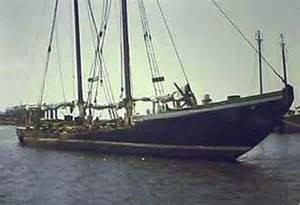
A snapper smack from the 19th century.
Photo: Brown Marine Pensacola
So what do we know about this “king of finfish”? Well, red snapper begin their lives like most fish, as planktonic larva. The larva first appear in northern Gulf around May and are found through November, with numbers peaking from July through September. Though they settle out from the plankton near hard structure, muddy bottom habitats appear to be very important as foraging grounds. Red snapper seem to stay close the hard structures they settle out near, though some movement does occur, particularly with snapper living deeper than 120 feet. They feed on zooplankton when they are young and move to a diet of small reef fish and crustaceans as adults; mantis shrimp are a particular favorite. Red snapper have been reported to live all most 50 years.
The problems with the fishery began in the mid 20th century. Though snapper were listed as overfished by the National Marine Fisheries Service their problems go beyond just overfishing. By-catch in shrimp trawls is a particular problem. Much research and money have been spent to solve this problem. Science has found that young snapper, typically caught in trawls, do not like bright light and experimental trawls with LED lighting have been tested; studies continue.
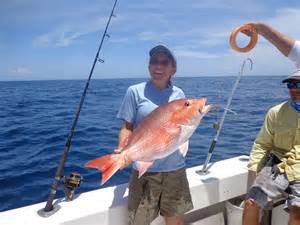
The king of finfish… the red snapper
Photo: Florida Sea Grant
In 1976 the Magnuson-Stevens Fisheries Conservation and Management Act was passed. By 1984 the first size and bag limits were issued and by 1988 the fishery was officially listed as overfished. Success at increasing numbers with the size and bag limits was low due to the shrimping by-catch issue and because many were not surviving the catch and release methods being used to return undersized fish. Studies show that snapper captured at depth experienced pressure problems as they are reeled to the service. This drastic change in pressure caused their swim bladders to expand, or rupture, a process known as barotrauma. Undersized (or over limit) fish had to be released. Those experiencing barotrauma were not surviving. Their expanded swim bladders would cause some to float – typically called “floaters” – and they were easy targets for sharks and dolphins. Others may descend slowly or reach the bottom but are still under stress and, again, were easy targets. Others still survived the release only to have issues with growth and immune function. Several techniques are used by fishing to reduce barotrauma, such as venting, but their success is debated and is currently under study.
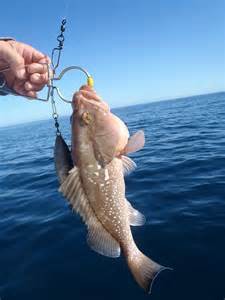
One of the many version of descending devices used by fishermen to return snapper to depth.
Photo: Florida Sea Grant
Despite management plans the fishery is still considered overfished. Solving the problem will require plans to deal with the by-catch and barotrauma issues but will also have to address the socio-economic issues of the management itself. Many families depend on this fishery for their livelihood and though a complete ban on the species for a period of time may be beneficial to the fish stock, it may not be practical. Researchers, fisheries managers, and others will continue to work on solving this problem and hopefully the “king of finfish” will be with us for a long time.
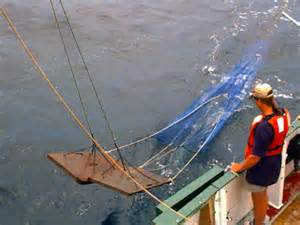
by Rick O'Connor | Oct 9, 2015
Shrimp… nothing says seafood along the Gulf coast like shrimp. It has been a staple part of our diet for decades; boiled, fried, steamed, stuffed, shish-kabobbed, As Forrest Gump said there are a million ways to cook shrimp and as Jack and Anne Rudloe mention their book, Shrimp, the Endless Quest for Pink Gold, there are many cookbooks dedicated to preparing one of the most popular seafood species.
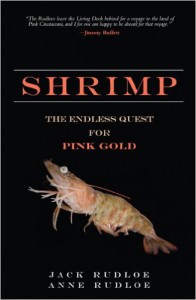
The book published by jack and Anne Rudloe in 2010.
Growing up in Pensacola I remember the shrimp boats lining Palafox Street at the Bayfront Auditorium. You could drive down with your cooler almost any day and purchase white or brown shrimp for $2-3 a pound. The boats were beautifully painted with red and blue colors. Their coolers were full and we would fill ours, take them home, de-head them, and then have to decide how we wanted to prepare them… fry? Shrimp and grits? Boiled? They were college football tail gating food, birthday celebrations, and I cannot remember a wedding reception I went to, including my own, where shrimp was not served in some form or fashion. It’s a great product, taste great, and good for you. Bu things are changing…
Locals along the panhandle might be surprised that shrimping, as we know it, did not begin here. Many who think of “shrimping” immediately think of Louisiana, Mississippi, and Alabama. Old wooden boats with nets draped everywhere and the familiar sound of the diesel engine in the early morning silence as they bring in the evenings catch. But according to the Rudloe’s commercial shrimping began in California. In their book they describe the evolution of the shrimping industry. Shrimp were in abundance in early human history, and relatively easy to catch. Archeologists assume they consumed large quantities of them but their chitonous shells do not preserve well so we are not sure. There are preserved nets from that time period which probably captured shrimp along with other small nearshore species. They were harvested in Europe, Africa, and certainly Asia using both nets and traps.
As these cultures came to the New World they brought with them the methods of capturing. Native Americans too used weirs and traps to collect. But it was Chinese who came to San Francisco during the gold rush that brought the idea of pulling nets behind their Chinese Junks and small shrimping villages began to pop around the Bay area. Though Cajuns had been shrimping in the Gulf before the Declaration of Independence was signed using beach seines, trawling behind boats did not come until later. At first these earlier shrimpers used sailing schooners and hauled the nets by hand but eventually the internal combustion engine arrived and both boat and winch power made the job easier and they could stay our longer. Dried shrimp was how the product was sold at first but the introduction of refrigeration meant shrimp could be brought in fresh, and the laundry list of how to prepare began. The amount of shrimp demanded stronger vessels, they switched from wood to steel and fiberglass vessels, and stronger power to pull these large nets, and they switched to diesel. With better vessels and power they could drop more than one net, shrimp boats were now seen with double booms and they could move farther offshore.
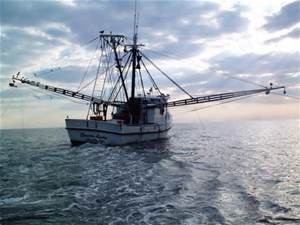
Shrimping.
Photo: NOAA
There are literally thousands of different species of shrimp in the world’s oceans but only a few are collected for food. In some cultures the small inshore species are the targets. Today some prefer the deep water ruby reds that could be collected only when the technology allowed. But most of us prefer shrimp from the Family Penaidae. White shrimp (gulf shrimp – Litopenaeus setiferus), brown shrimp (bay shrimp, “brownies” – Farfantepennaeus aztectus), and the pink shrimp (Farfantepenaeus duorarum) are the species locals enjoy. 90% of these three species sold are harvested from the Gulf of Mexico supporting, in some cases, whole communities. Then things began to turn “south”…
According to NOAA’s Fishwatch.gov the fishery is not currently being overfished. The problem with today’s shrimping industry is economic and environmental.
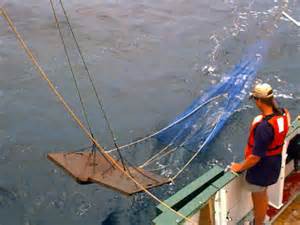
The basic otter trawl used for shrimping.
Photo: North Carolina State University
Economically, the cost of diesel has increased and for a 12,000 gallon vessel can cost the fishermen $50,000 per trip.
Bartering with wholesalers, many shrimpers will make 45% of their annual income in the first 45 days of the shrimping season, making tough times down the road – literally a “boom-bust” business.
Aquaculture… farmed raised shrimp has been around for centuries and the increased demand for the product many have turned to farmed shrimp to keep cost down. Many will be surprised to learn that 80-90% of the seafood consumed in the United States is farmed product from overseas. These low prices are difficult for the traditional ocean harvesting shrimper to compete with. You may also not know that a large amount of the product farmed overseas is not allowed to enter into the United States because of their method of using hormones to accelerate growth.
Environmentally, the trawl… As they drag their nets across the bottom they remove a lot of marine life in addition to the target species of shrimp. The otter trawl is opened using wooden doors and is pulled along the bottom using a chain (known as a “tickler”) to force the buried nocturnal shrimp to “pop up”. Trawled over seagrass beds they can do a lot of damage. Some studies have shown that almost 60% of the catch is what has been termed “trash fish” or “by-catch”. The Ocean Conservancy reports that after the World War II, when technology significantly improved for shrimpers, the by-catch to shrimp ratio was 4:1. Pressure from environmental groupers and other fisheries forced regulations on when, where, and how trawling would occur in attempts to reduce by-catch and damage to sensitive bottom habitat.
Sea turtles… one of the by-catch species were the federally protected marine turtles. This forced a change that required a Turtle Excluder Device (TEDS) to be installed into the trawl.
The oil spill… shrimpers certainly suffered from this incident and 10 years later in many parts of the Gulf the problems still exist.
We of course cannot forget “Mother Nature”. Hurricanes can change the ecology of the system enough to decrease available shrimp for several years.
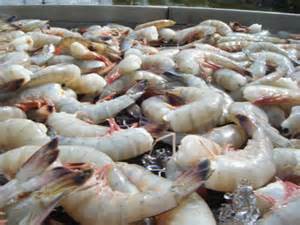
The famous Gulf Coast shrimp.
Photo: Mississippi State University
All in all these economic and environmental issues have forced many out of the business. A few years ago the shrimping fleet in Pensacola numbers between 40 and 50 vessels, today there are about 10. Times are hard on the traditional shrimper… but despite these setbacks it still remains one of the more popular seafood species.

by Rick O'Connor | Oct 2, 2015
While directing the Marine Science Academy for the Escambia County School District I had students conduct small, informal, surveys targeting the popularity of seafood with students, parents, and the community. The purpose of these surveys was to kick start a discussion on the commercial fishing issue. The northern Gulf Coast has been known for several popular seafood products over our history; oysters, blue crab, mullet, snapper to name a few. There are two basic paths a commercial fishery can move as they grow their business. Fish for what they know and is easily harvested and convince the public to purchase – marketing. OR they can find out what the public wants and then develop a fishery to target those species. Hopefully they will find common ground; something that is available, easy to harvest, and popular with the public.
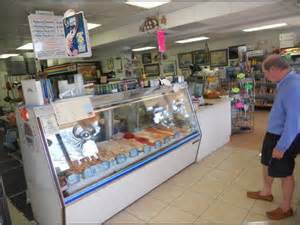
There are about 80 species of commercial seafood products that come from Florida.
Photo: Florida Sea Grant
In those surveys we looked at young and old, male and female. A couple of trends became apparent over the 20+ years we conducted these (remember, low level high school survey… but still interesting). (1) Shrimp was the no.1 favorite with all groups. That’s good, shrimping in the northern Gulf is a do-able product – many will say the best shrimp comes from these waters. But we also know that shrimping has hit hard times; more on this next week.
(2) With males No.2-5 are typically fish, with females it varies from fish to calamari, to sushi, to other. Popular fish of course are grouper and snapper… and we all know the issues with these target species in our area. There are lesser known fish with the general public, though many locals know, such as sheepshead, tilefish, pompano, that are not typically on menus. And of course a local favorite… mullet. With the mix request beyond fish include squid, crab, sushi grade fish, lobster, and others. Some of these are not common in our area and must be transported in. For many where the fish comes from does not really matter – for others it does (more on this in our last addition this month). But as you can see this type of information plays a role on how the seafood business works in the northern Gulf.
(3) The first question on the survey was “do you like seafood?” Of course if the answer was no then it was not necessary to ask further questions. The trend we saw over time was more and more stating they did not like it. Curious… I mean there are things I do not like either – so there is no problem not liking seafood – but we were curious as to why… so we added that to the survey. Our thought as we began was seafood safety. At the time much of the seafood landed was sold at a wholesale or retail market with little or no inspection – did this concern folks? In our survey we found that in most cases it did not. They just did not like the taste… fair enough.

Shrimping.
Photo: NOAA
What do the bigger surveys say? In 2014 an article was posted in the Wall Street Journal discussing this issue and what other surveys found. (1) There was a decline consumption. In 2012 Americans consumed an average of 14.4 lbs of seafood/person. This was down from 15.0 lbs in 2011 and 16.6 lbs in 2004. For comparison, at that time Japanese consumed 120 lbs/person/year and Spain consumed 96 lbs. To compare this with the “big three” at that time Americans consumed 46 lbs of pork, 57 lbs of beef, and 82 lbs of chicken/person/year. Chicken is king… it is a white meat, Americans are trying to eat healthier, but fish is a white meat… so why not fish?
The surveys indicated the top reasons were
- Do not know how to cook
- The price of seafood is high
- Marketing – the seafood industry is fragmented and marketing efforts on the healthy benefits have not happen (or if done, were not done as well as the focused effort of the chicken industry).
To a lesser extent there was concern over safety (particularly mercury) and some concern about genetically modified farm raised fish (salmon in particular was mentioned). Members of the chicken industry highlighted the cost of production for seafood as a barrier for them. It cost more to go to sea and harvest seafood (or raise salmon in ocean pens) than it does to produce the “big three” on farms.
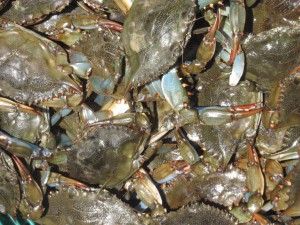
The crab of choice in the northern Gulf of Mexico; blue crab.
Photo: FWC
This year Florida Sea Grant published an article in the September issue of Florida Trends on this issue. Sea Grant pointed out that currently the national consumption of seafood is up to 15 lbs and that Floridians consume 31 lbs/person/year… so there is a trend upwards since the Wall Street Journal’s 2014 article. However 40% of Floridians do not consume 2 servings a week (as suggested by the U.S. Department of Agriculture).
We can state that seafood is healthy for you and it is safe to consume (check out Florida Sea Grant for more on this). What I am finding is that there is a small group of locals now concerned with whether the seafood they are consuming is coming from local fishermen. We will discuss more on these topics in later editions.
Enjoy seafood.

by Rick O'Connor | Oct 2, 2015
They are marvelous creatures and there are very few panhandle residents who know what they are. My wife and I were introduced to Diamondback Terrapins by George Heinrich in 2005. George was the president of a nonprofit, Florida Turtle Conservation Trust, and a member of the Diamondback Terrapin Working Group, a national group of terrapin researchers and educators. He, and these organizations, were very interested in the status of terrapins in the Florida panhandle… so Molly and I took that job on.
Diamondback terrapins (Malaclemmys terrapin) are the only true brackish water resident turtle in the United States. They range from Cape Cod MA down the entire eastern seaboard, across the Gulf of Mexico to Brownsville TX. Within that range there are 7 described subspecies, 5 of those found in Florida, 2 found in the Florida panhandle. These estuarine turtles prefer salt marsh and mangrove habitat. They are very reclusive and difficult to find – hence why most locals have never seen nor heard of them. When I talk about them to the public I get responses such as… “do you mean tarpon?” “I find those in my yard all of the time” (probably a different species), “aren’t those from up north?” and “never heard of them”… they are not fish so they could be found in your yard if you live along the fringes of a salt marsh, they are up north – but they are here also.
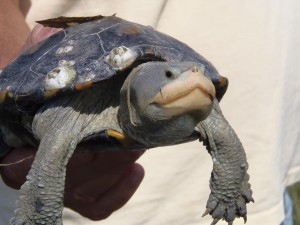
Diamondback terrapin found in Wakulla County.
Photo: Molly O’Connor
In 2005 Molly and I were asked to survey the panhandle and determine if terrapin populations still exist. We decided to take that job on and then expand to determine their population size and whether those populations are increasing or decreasing. The coastal panhandle extends from Escambia County (on the Alabama state line) to Jefferson County (Aucilla River), but due to existing funding we could only survey to the Apalachicola River. This would include six counties: Escambia, Santa Rosa, Okaloosa, Walton, Bay, and Gulf. We verified at least one record of a terrapin in each county. We discovered the larger the expanse of salt marsh – the higher probability of terrapins; thus those counties with relatively little salt marsh (such as Okaloosa) would have fewer/smaller terrapin populations.
But marsh alone is not enough. Terrapins need high ground in which to lay their eggs. High ground within a marsh is not a common thing. Research shows that terrapins will travel up to 5 miles in search of suitable nesting; which means a terrapin could be found in your neighborhood even if no marsh is visible. Unlike sea turtles they are “home-bodies” rarely leaving the marsh where they were born. They spend time forging for shellfish (particularly the snail called marsh periwinkle – Littorina irorata) and basking on and in the mud. They can be seen at the surface with their heads peering at you – they seem to be very curious.
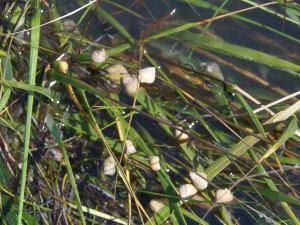
Marsh periwinkles will climb cordgrass to avoid predation by blue crabs and terrapins.
Photo: Molly O’Connor
Once we confirmed that terrapins were still in the panhandle we then began work on how many. To do this we needed to find their nesting beaches. Terrapin nesting season is about the same as that of sea turtles (May 1 – Aug 1); some nesting may occur after that but few. Unlike sea turtles they nest during daylight hours and prefer sunny days over cloudy/raining ones. They like to nest at high tide – thus finding a suitable location that is out of the way of potential flooding by the rising bay – however this does not account for severe storms. They typically lay about 10 eggs in their nest, cover and disguise, and then leave it to its fate. Unfortunately in many nesting areas, its fate is to be uncovered and consumed by predators – particularly raccoons. Molly and I would kayak salt marshes searching for suitable nesting beach. Once found, we would walk the beach looking for sign of nesting. If nesting was found this would be recorded and we would then begin 16-day monitoring trips. It is assumed that each sexually mature female within the population will nest once every 16 days; and they will nest more than once each year. Signs of nesting include tracks (which are counted), and egg shells from a nest that was raided by a raccoon (which were logged and removed). Occasionally we would come across a nesting female. We would allow her to complete the nesting activity and then capture her for measurements and photographs. We would mark her with a notch on the margin of the carapace (top shell) and release her (we did not have the funding for PIT tags). We would also set modified crab traps to capture them. Terrapins have a habitat of entering crab traps (probably more for the bait than the crabs) and becoming entrapped. Unless found within 15-30 minutes, they will drown. Our modified crab traps were tall enough that terrapins could reach the surface (even at the highest tide) and get a breath of air. We would set traps for 5 day periods and (if we caught any at all) would only capture during the first day or two. Terrapins are smart and we found that after day 2 most would approach our traps, observe our handy work, and swim away. With the data from these two activities we could get a rough idea of how many terrapins were in this population and how they changed over time.
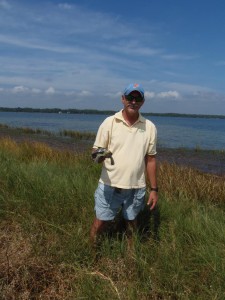
The marshy habitat terrapins love.
Photo: Molly O’Connor
We focused our population surveys to our home counties of Santa Rosa and Escambia counties. We were able to identify 1 nesting beach in Escambia and 2 in Santa Rosa (we have since found a 3rd). We never caught a terrapin in Escambia but had good success at one of the two beaches in Santa Rosa. That population had approximately 50 individuals living within it. From 2007 to 2012 the population remained relatively stable. In 2012 I changed jobs and have not had a chance to re-survey. I plan to do this in 2016.
This year we trained 24 volunteers to assist us in locating and monitoring nesting beaches. They did find a new nesting beach in Santa Rosa and will begin monitoring nesting activity and trapping next year.
These are fascinating creatures and one of the most beautiful turtles you will ever see. Some have asked me about state protection for them. They are listed as a freshwater turtle with FWC thus you cannot possess more than two, cannot have any eggs, and cannot sell them.
If you have questions about diamondback terrapins, are interested in participating in terrapin surveys in Escambia and Santa Rosa counties, or would like to begin your own surveys in your county. Contact me (Rick O’Connor) at roc1@ufl.edu or (850) 475-5230.



















